Abstract
The iterative Fourier transform algorithm (IFTA) is widely used in various optical communication applications based on liquid crystal on silicon spatial light modulators. However, the traditional iterative method has many disadvantages, such as a poor effect, an inability to select an optimization direction, and the failure to consider zero padding or phase quantization. Moreover, after years of development, the emergence of various variant algorithms also makes it difficult for researchers to choose one. In this paper, a new intelligent hybrid algorithm that combines the IFTA and differential evolution algorithm is proposed in a novel way. The reliability of the proposed algorithm is verified by beam splitting, and the IFTA and symmetrical IFTA algorithms, for comparison, are introduced. The hybrid algorithm improves the defects above while considering the zero padding and phase quantization of a computer-generated hologram, which optimizes the directional optimization in the diffraction efficiency and the fidelity of the output beam and improves the results of these two algorithms. As a result, the engineers’ trouble in the selection of an algorithm has also been reduced.
1. Introduction
In recent years, there has been an increasing demand for network transmission with the gradual popularization of social media. The spread of the COVID-19 pandemic has also spawned a variety of teleworking applications, such as video conferencing, online teaching, and webcast [1], which are driving the current optical network to become more efficient and intelligent. Reconfigurable optical add/drop multiplexers (ROADM), flexible optical network nodes with characteristics of being colorless, directionless, contentionless and gridless (CDCG), are considered as the basic building blocks of future high-speed and large-capacity intelligent optical networks [2,3,4]. The application of CDCG-ROADM, to a certain extent, is expected to meet people’s demand for optical networks.
ROADM provides wavelength-switching capabilities in most optical networks, enabling the free connectivity of multiple dimensions or directions. The original ROADM was a combination of a wavelength blocker (WB) and a wavelength division multiplexer. Bell LABS implemented WB ROADM with 64 channels, but this technical solution was gradually abandoned due to its poor multidimensional scalability and difficulty in realizing CD functionality. The second generation of PLC-based ROADM is highly valued due to its low cost and reliability. JDSU and DuPont have implemented the second generation of ROADM with 40 channels and a 100 GHz interval, but ROADM equipment has the problem of fixed-channel characteristics and insufficient flexibility.
Over several generations’ development, the wavelength selective switch (WSS), constructed with phase-only liquid crystal on silicon spatial light modulator (LCOS-SLM), has gradually become the core component of ROADM [5,6,7,8,9]. Y. Ma et al. proposed a 1 × 34 WSS and a 16 × 8 multicast switch to implement the CDC function of ROADMs [10]. H. Yang et al. stack 48 independent 1 × 12 WSSs on a 4k LCOS in a flexible way, a design that can better realize the switching function in CDC-ROADM [11]. However, the overall structure of CDCG-ROADM based on 1 × N WSS is very complex, and the power consumption and cost are very high. The development of M × N WSS can greatly reduce the construction, operation, and maintenance costs of ROADM nodes, reducing the system complexity and promoting the rapid development of the next generation of intelligent optical network technology. NTT [12] and Lumentum [13] use different technologies to implement an 8 × 24 ROADM, which is currently the highest number of ports available in such system.
Beam splitting is an important application in ROADM. Flexible control of the wave front can be achieved by loading a computer-generated hologram (CGH) onto LCOS. The beam-splitting scheme based on LCOS-SLM mainly includes a SLM-splitting algorithm and an iterative calculation method. The principle of the SLM-splitting algorithm proposed by A. Gomez et al. is relatively intuitive [14]. According to different beam-splitting angles, SLM is divided into regions, and only a single beam is processed in each region. Phase holograms of each region are obtained by calculating analytical solutions and integrating them. Quan You et al. have proposed an improved solution that increases the rotation of CGH and extends the beam splitting from 1D to 2D [15]. This kind of scheme is simple and intuitive, with high diffraction efficiency, but it has some problems, such as insufficient flexibility, a small number of split beams and a susceptibility to proportional imbalance. As for iterative schemes, Dmitriy Mikhaylov et al. propose a novel method of reusing machine learning and the iterative Fourier transform algorithm (IFTA) method [16] that produces better results as compared with the IFTA. However, the algorithm needs a lot of learning, according to the predetermined points in each calculation, so it cannot conveniently set the split points and has low flexibility.
In addition to the above methods, after years of development, a variety of IFTA-based variant algorithms have emerged, with many parameters that can be set freely. Although most of the algorithms are not designed for the specific application of beam splitting, they still solve the phase recovery problem in its essence, so they can be used for beam splitting, with some modification.
These variant algorithms mainly improve the quality of CGH in the following ways: (1) using phase freedom and amplitude freedom [17]; (2) selecting the appropriate scale factor [18]; (3) introducing noise (amplitude or phase) to make the algorithm jump out of stagnation; (4) calculating the required phase directly with a global algorithm [19,20]; (5) combining deep learning [16,21,22,23]. The emergence of various algorithms not only improves the calculation results, but also brings a new problem for optical engineers; that is, how to choose the appropriate algorithm [24]. Depending on the actual application, optical engineers choose different optimization indicators, such as the optical signal’s diffraction efficiency, uniformity, or fidelity. However, the IFTA cannot balance different indexes and perform directional optimization.
While many algorithms can produce better optimization results, zero padding and phase quantization are not taken into account. These operations must be carried out in calculating CGH in practical applications. The calculation results, obtained directly without zero padding, are inaccurate, as speckle on their images cannot be fully displayed [18]. In addition, the current LCOS can only load a limited quantized phase, and its common quantization depth is 256 levels. However, the phase calculated by the IFTA algorithm changes almost continuously, and the basic method of direct quantization causes quantization noise.
This paper presents an intelligent hybrid algorithm based on a LCOS-SLM for beam splitting. The differential evolution (DE) algorithm and IFTA are deeply integrated. The proposed algorithm takes the zero padding and phase quantization of CGH into consideration, which can further optimize the results of other algorithms. In addition, by setting appropriate merit functions, a certain degree of directional optimization can be carried out between the diffraction efficiency and fidelity of the output optical signal, which also relieves the engineer’s trouble in algorithm selection.
2. Description of the Algorithms
The algorithm proposed in this paper needs to combine the IFTA and DE algorithm. The principles of the algorithms are as follows.
2.1. The Iterative Fourier Transform Algorithms
The basic IFTA algorithm obtains the phase distribution by bouncing back and forth between the object domain and the Fourier domain [24]. The steps are as follows:
- Combine the amplitude of the incident beam with a random phase to form the complex amplitude. Then, take the Fourier transform of the complex amplitude.
- Combine the phase distribution of the Fourier domain with the target amplitude distribution to form a new complex amplitude. Then, perform an inverse Fourier transform on the complex amplitude.
- Replace the random phase in step 1 with the phase distribution of the object domain in step 2;
- Repeat steps 1–3 until the merit function is satisfied or the iteration stagnates.
The red area in Figure 1 is the flow chart of IFTA, where and are the intensity distribution of the incident beam and the target beam respectively, and are the Fourier transform and inverse Fourier transform respectively, and is the scaling factor. For the basic IFTA, is equal to one.
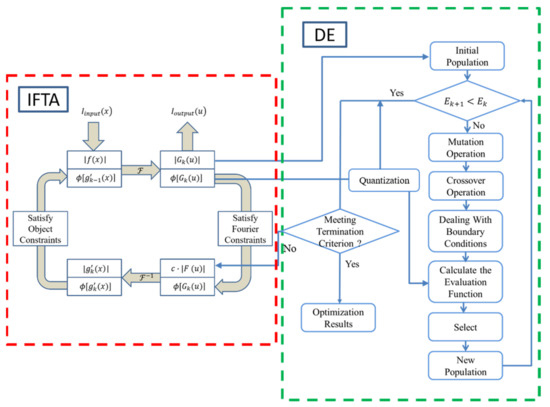
Figure 1.
Block diagram of the proposed algorithm. The red box is IFTA. The green box is DE.
In order to illustrate the effect of the proposed algorithm, a symmetrical IFTA (SIFTA) algorithm is selected for further comparison [25]. In the absence of zero padding and phase quantization, SIFTA performs very well in signal fidelity optimization. However, once necessary processing completes, the diffraction efficiency and fidelity of the output beam are reduced. SIFTA obtains better optimization results by replacing the Fourier domain amplitude constraints as
where is the original complex amplitude distribution in the Fourier domain, is the complex amplitude distribution of the input beam, and SW is the signal window.
2.2. The Differential Evolution Algorithm
Like most typical intelligent optimization algorithms, DE is also inspired by artificial intelligence and the natural laws of biological populations [26,27,28,29]. The DE algorithm simulates the cooperation and competition among individuals in a population to optimize the convergence of the function, and the optimization process mainly includes three parts: variation, crossover, and selection. The DE algorithm processes random individuals in the original population through mutation and crossover, then compares the new individuals with the original individuals by evaluation value and selects the next generation of individuals to form a new population by survival of the fittest, as shown in the green box of Figure 1. To accelerate the optimization and improve the calculation accuracy of DE, the algorithm proposed in this paper uses the calculation results of IFTA and SIFTA instead of using a random array as the initial population. In this proposed algorithm, the amplitude distribution of the Fourier domain after zero padding is selected as individuals, and multiple groups of individuals are selected to form a population in the iteration. The phase quantization is incorporated into the whole cycle and the corresponding evaluation value is calculated. Specifically, this operation is equivalent to setting as an individual and replacing the target amplitude in the Fourier domain of the basic IFTA. This algorithm calculates the appropriate target amplitude distribution in real time, according to the results of each iteration, to achieve optimal optimization.
Image generation, beam splitting, and beam shaping are three typical applications of LCOS-based phase recovery. For the same design problem, they are different optimization directions, and one needs to find a balance between the root–mean–square error , the diffraction efficiency , and the uniformity of the emitted beam. The traditional IFTA algorithm has difficulty achieving this balance. However, as in other intelligent optimization algorithms, the DE algorithm can achieve directional optimization by setting different merit functions.
2.3. The Proposed Algorithm
The algorithm in this paper mainly includes the following steps:
- First, make the necessary zero padding for the initial sampling points, and then use IFTA or SIFTA to optimize until they stagnate. Obtain the complex amplitude in the Fourier domain.
- According to the preset number, select the amplitude distribution in the signal window of the Fourier domain multiple times to form the initial population.
- Quantify the phase distribution in the Fourier domain to obtain and substitute it into the merit function, together with the population. Get a set of evaluation values, A.
- Then subject the population to mutation, crossover, and boundary processing, in sequence.
- Substitute the processed population and into the merit function to calculate the evaluation value, B.
- Compare A and B to select the better individuals from which to form a new population.
- Calculate the evaluation value, C, of the new population and compare it with A. If it becomes worse, continue to perform steps 3–7; otherwise, perform step 8.
- Compare the optimal evaluation value with the target value; if it is satisfied, stop the iteration and output the optimal individual, otherwise replace with the optimal individual and enter the IFTA loop to continue performing steps 1–7.
Both phase freedom and amplitude freedom are applied in the algorithm, and is optimized by the DE algorithm, which is equivalent to realizing the automatic optimization of scale factor and target amplitude at the same time. As mentioned above, the introduction of the DE algorithm allows the algorithm to achieve directional optimization to meet a variety of specific applications.
3. Results
In this paper, the performance of the proposed algorithm is demonstrated by a simulation of beam splitting. The simulation uses Holoeye’s 4k LCOS to load the holograms. In order to match the actual application and better illustrate the algorithm effect, this paper only selects = 1024 pixels in the middle part of the x axis as the effective pixel area, which also reduces calculation by a certain amount. To show speckles in the output image as much as possible, this work uses 10-fold excess zero padding. Thus, the total sampling points on the x axis are 10,240, and the number of actual effective sampling points is 1024 in the middle. Table 1 shows some parameters used in the simulation.

Table 1.
Some parameters used in simulation.
The distribution of the incident beam is
where is the radius of the incident Gaussian beam at 1/e, and = 0.96 mm and EA is the effective pixel area. The target distribution is two groups of Gaussian beams with a peak intensity ratio of 5:4, and each of these Gaussian beams is , where = 0.15 mm.
According to different application situations, the merit function has different selection rules. For beam splitting, it is more appropriate to select diffraction efficiency and root–mean–square error as the merit function. It should be noted that, different from many efforts, we set the effect area of diffraction efficiency and root–mean–square error differently. The signal window (effective output area) is selected as the calculation location of root–mean–square error, and the measurement area (beam splitting area) is selected as the calculation location of diffraction efficiency, as shown in Figure 2. The setting of the merit function can distinguish the diffraction efficiency and fidelity of the output beam to the greatest extent and realize the optimal orientation optimization.
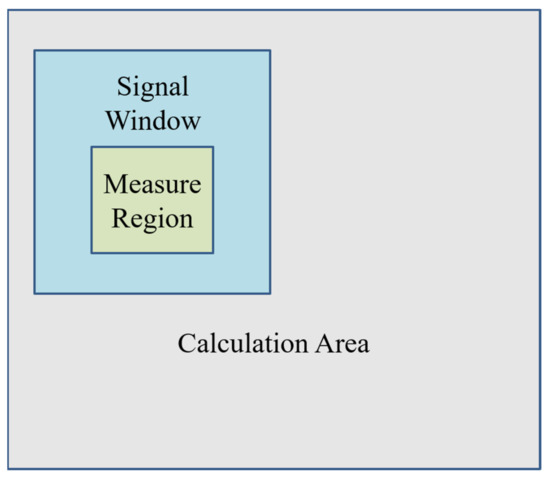
Figure 2.
Region division of the signal window, measure region, and calculation area.
Diffraction efficiency:
where is the output beam intensity of the measurement area and is the total output beam intensity distribution. The root–mean–square error (RMSE) is given by:
where is the number of sampling points of the signal window and is the output beam intensity distribution of the signal window. The merit function is:
where m and n are the weighting factors of diffraction efficiency and root–mean–square error, respectively, which are used to adjust the optimization direction. is the proportional coefficient, which is used to adjust the dimensions of diffraction efficiency and root–mean–square error.
Figure 3 shows the simulation results of beam splitting; all the intensity distributions are normalized. Figure 3a,b shows the intensity distribution of the incident beam and target beam, respectively. Figure 3c,d shows the optimization results of IFTA and SIFTA, respectively. Table 2 shows the key evaluation values in Figure 3.
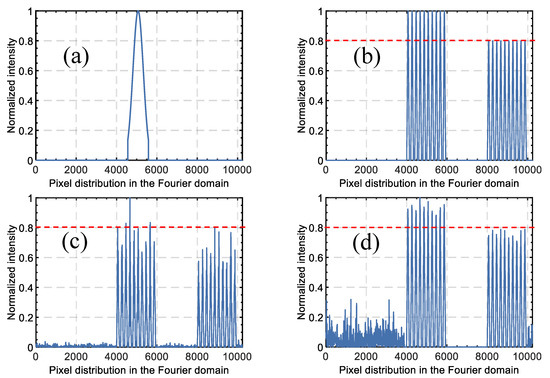
Figure 3.
Simulation of beam splitting; (a,b) the intensity distribution of incident beam and target beam, respectively; (c,d) the optimization results of IFTA and SIFTA, respectively.

Table 2.
The optimal evaluation value of the two basic algorithms.
It can be analyzed that IFTA performs well in terms of diffraction efficiency but is poor in terms of fidelity. SIFTA sacrifices part of the diffraction efficiency and has greatly improved the fidelity. It should be noted again that the parts outside the signal window are not needed. Therefore, they will only affect the diffraction efficiency and will not be included in the calculation of the RMSE.
Figure 4 shows the simulation results of the proposed algorithm, where m/n = 5/1. This is equivalent to slightly biasing the optimization result toward the diffraction efficiency. Figure 4a,b shows the intensity distribution. The initial populations in Figure 4a,b are those in Figure 3c,d, respectively. That is, the proposed algorithm is used to optimize the results of IFTA and SIFTA. Figure 4c,d shows the optimized curves of Figure 4a,b, respectively. Orange represents diffraction efficiency, and green represents RMSE. Table 3 shows the key evaluation values of Figure 4.
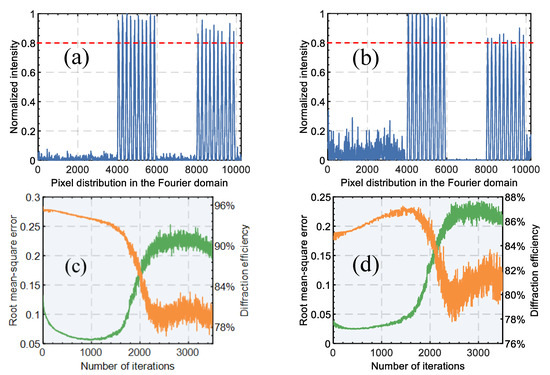
Figure 4.
The optimization results of the proposed algorithm, m/n = 5/1; (a,b) the intensity distribution; (c,d) the merit curve; (a,c) the optimization of the proposed algorithm to the result of IFTA; (b,d) the optimization of the proposed algorithm from the result of SIFTA.

Table 3.
The optimization results of the proposed algorithm when different algorithms are used to generate the initial population, where m/n = 5/1.
It can be seen that after the optimization of the algorithm proposed in this paper, the RMSE of IFTA and SIFTA has been further improved, and the diffraction efficiency of SIFTA has also been improved, to a certain extent. The diffraction efficiency of IFTA is reduced by only about 1.5%, while RMSE is much improved, which is necessary for applications requiring high diffraction efficiency, such as beam shaping.
Figure 5 shows the optimization result of the proposed algorithm when m/n = 1/5, which is equivalent to biasing the result slightly towards the fidelity. Figure 5a,b shows the intensity distribution. The initial populations in Figure 5a,b are those from Figure 3c,d, respectively. Figure 5c,d shows the optimized curves from Figure 5a,b respectively. Table 4 shows the key evaluation values of Figure 5.
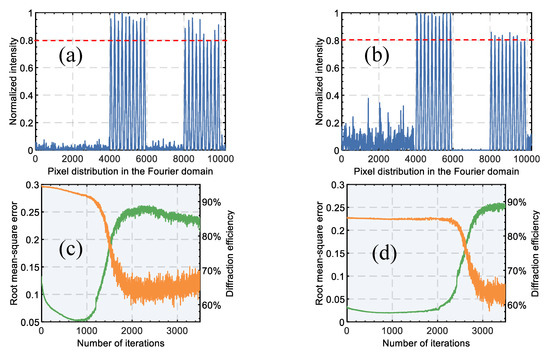
Figure 5.
The optimization results of the proposed algorithm, m/n = 1/5; (a,b) the intensity distribution; (c,d) the merit curve; (a,c) the optimization of the proposed algorithm to the result of IFTA; (b,d) the optimization of the proposed algorithm to the result of SIFTA.

Table 4.
The optimization results of the proposed algorithm when different algorithms are used to generate the initial population, where m/n = 1/5.
It can be seen that when we prefer to optimize the fidelity of the output beam, the RMSE of the two algorithms has been further reduced. For IFTA, the proposed algorithm can greatly improve its RMSE from 0.1328 to 0.0517, and the diffraction efficiency is only reduced by 2.84%. For SIFTA, the proposed algorithm improves its RMSE and diffraction efficiency simultaneously. The RMSE can be reduced from 0.0393 to 0.0194, and the diffraction efficiency can be increased from 84.47% to 85.37%. It surpasses SIFTA in terms of diffraction efficiency and fidelity, and further optimizes the results of SIFTA. This increase in beam fidelity is very suitable for beam splitting and multilevel image generation.
In order to further verify the reliability of the algorithm, we set and randomly generate five control groups in the same simulation, and set m = n = 1 to optimize the SIFTA results as a whole. Table 5 shows the results of specific simulation data. Taking the average value as the measurement standard and the IFTA result as the reference value, it can be seen that the diffraction efficiency of SIFTA is reduced to 83.94% of IFTA, but the root–mean–square error is also reduced to 41.53% of IFTA, which greatly improves the IFTA result. For the algorithm proposed in this paper, the diffraction efficiency is basically the same as SIFTA under the overall optimization of m = n = 1, while the root–mean–square error is reduced to 21.05% of IFTA, and the fidelity of the output beam is further improved. These data further prove the reliability and stability of the proposed algorithm.

Table 5.
Five random simulation results when m = n = 1. The data in the table are diffraction efficiency on the left and root–mean–square error on the right.
4. Discussion and Conclusions
It should be noted that the proposed algorithm does not further optimize the diffraction efficiency of IFTA results considering IFTA does not use amplitude freedom, because there is not enough room for optimization. For SIFTA, which uses both amplitude freedom and phase freedom, there is still some improvement room for its results after zero padding, thereby achieving more optimal effects. Therefore, if we choose other algorithms to replace IFTA and SIFTA, we need to analyze whether the algorithm leaves enough gap for optimization and how to set an appropriate merit function to get the desired results.
In addition, physical impairments in optical links can also affect ROADM systems, limiting transmission distances, such as the attenuation of signal optical power, the dispersion of transmission fibers, and noise caused by amplifiers. When the optical signal reaches LCOS, the actual input beam is likely to be different from the simulation parameters. For the algorithm with high accuracy in this paper, the impact is more serious, which may lead to the reduction of diffraction efficiency and the decrease of beam fidelity. The power balance can be achieved by determining the appropriate beam-splitting ratio, and the dispersion in the optical link can be compensated for by loading the appropriate programmable diffractive optical element on the LCOS. The above functions can be realized simultaneously by superposing the phase hologram of the beam-splitting and diffraction lenses in a certain way. At present, we are still studying this part to find a phase hologram multiplexing method suitable for ROADM.
Furthermore, some parameters need to be set manually in this algorithm, such as the mutation factor and crossover factor. In a following work, an adaptive differential evolution algorithm or other advanced algorithms can be introduced to make the algorithm more intelligent and efficient. We apply the algorithm to beam splitting, and only RMSE and diffraction efficiency are selected as the merit function. More evaluation indexes can also be introduced to meet different application requirements if necessary.
In conclusion, based on LCOS-SLM, we present an intelligent hybrid algorithm that can well achieve the beam splitting and further optimize the original algorithm’s results. We have also considered the zero padding and phase quantization of CGH simultaneously. By setting up appropriate simulation experiments, the performances of IFTA and SIFTA in beam splitting are compared with that of the proposed algorithm. The proposed algorithm greatly improves the fidelity of the output beam and reduces the root–mean–square error to one fifth of the original result. By setting different weight values, the proposed algorithm achieves directional optimization of the diffraction efficiency and fidelity of the output beam and is expected to extend this function to other evaluation indexes. The reliability and stability of the proposed algorithm are verified by multiple random simulation experiments at the same time.
Author Contributions
Conceptualization, X.Z.; methodology, X.Z.; software, X.Z.; formal analysis, X.Z.; investigation, X.Z.; resources, G.C.; data curation, X.Z.; writing—original draft preparation, X.Z.; writing—review and editing, X.Z. and G.C.; supervision, G.C.; project administration, Q.Z. and G.C.; funding acquisition, G.C. All authors have read and agreed to the published version of the manuscript.
Funding
Supported by the International Cooperation and Exchange of the National Natural Science Foundation of China (Grant No. 61960206013) and the National Major Scientific Instrument Development Project of the National Natural Science Foundation of China (Grant No.61627814).
Institutional Review Board Statement
Not applicable.
Informed Consent Statement
Not applicable.
Data Availability Statement
Not applicable.
Conflicts of Interest
The authors declare no conflict of interest.
References
- Nguyen, M.H.; Gruber, J.; Fuchs, J.; Marler, W.; Hunsaker, A.; Hargittai, E. Changes in Digital Communication During the COVID-19 Global Pandemic: Implications for Digital Inequality and Future Research. Soc. Media Soc. 2020, 6. [Google Scholar] [CrossRef]
- Aoki, Y.; Wang, X.; Nakagawa, G.; Oda, S.; Sone, K.; Tanimura, T.; Hoshida, T.; Palacharla, P.; Sekiya, M.; Rasmussen, J.C. Next generation photonic node architecture using software-defined universal transceivers. In Proceedings of the OFC 2014, San Francisco, CA, USA, 9–13 March 2014; pp. 1–3. [Google Scholar]
- Nakagawa, G.; Oda, S.; Sone, K.; Aoki, Y.; Hoshida, T.; Rasmussen, J.C. Demonstration of integrated optical path monitoring sub-system in CDCG-ROADM network. In Proceedings of the 2014 The European Conference on Optical Communication (ECOC), Cannes, France, 21–25 September 2014; pp. 1–3. [Google Scholar]
- Kozdrowski, S.; Żotkiewicz, M.; Sujecki, S. Optimization of optical networks based on cdc-roadm technology. Appl. Sci. 2019, 9, 399. [Google Scholar] [CrossRef] [Green Version]
- Peters, A.; Hugues-Salas, E.; Gunkel, M.; Zervas, G. Key performance indicators for elastic optical transponders and ROADMs: The role of flexibility. Opt. Switch. Netw. 2017, 25, 1–12. [Google Scholar] [CrossRef] [Green Version]
- Simmons, J.M. A Closer Look at ROADM Contention. IEEE Commun. Mag. 2017, 55, 160–166. [Google Scholar] [CrossRef]
- Strasser, T.A.; Wagener, J.L. Wavelength-Selective Switches for ROADM Applications. IEEE J. Sel. Top. Quantum Electron. 2010, 16, 1150–1157. [Google Scholar] [CrossRef]
- Collings, B.C. Advanced ROADM technologies and architectures. In Proceedings of the 2015 Optical Fiber Communications Conference and Exhibition (OFC), Los Angeles, CA, USA, 22–26 March 2015; pp. 1–3. [Google Scholar]
- Ma, Y.; Stewart, L.; Armstrong, J.; Clarke, I.G.; Baxter, G. Recent progress of wavelength selective switch. J. Light. Technol. 2020, 39, 896–903. [Google Scholar] [CrossRef]
- Ma, Y.; Suzuki, K.; Clarke, I.; Yanagihara, A.; Wong, P.; Saida, T.; Camatel, S. Novel CDC ROADM architecture utilizing low loss WSS and MCS without necessity of inline amplifier and filter. In Proceedings of the Optical Fiber Communications Conference and Exhibition (OFC), San Diego, CA, USA, 3–7 March 2019; pp. 1–3. [Google Scholar]
- Yang, H.; Robertson, B.; Wilkinson, P.; Chu, D. Stacked wavelength selective switch design for low-cost CDC ROADMs. In Proceedings of the OptoElectronics and Communications Conference (OECC) and Photonics in Switching (PS), Niigata, Japan, 3–7 July 2016; pp. 1–3. [Google Scholar]
- Ikuma, Y.; Suzuki, K.; Nemoto, N.; Hashimoto, E.; Moriwaki, O.; Takahashi, T. 8 × 24 Wavelength Selective Switch for Low-loss Transponder Aggregator. In Proceedings of the Optical Fiber Communication Conference Post Deadline Papers, Los Angeles, CA, USA, 22–26 March 2015. OSA Technical Digest (online) (Optica Publishing Group, 2015), paper Th5A.4. [Google Scholar]
- Colbourne, P.D.; McLaughlin, S.; Murley, C.; Gaudet, S.; Burke, D. Contentionless Twin 8 × 24 WSS with Low Insertion Loss. In Proceedings of the Optical Fiber Communication Conference Postdeadline Papers, San Diego, CA, USA, 11–15 March 2018. OSA Technical Digest (online) (Optica Publishing Group, 2018), paper Th4A.1. [Google Scholar]
- Gomez, A.; Quintana, C.; Faulkner, G.; O’Brien, D. Point-to-multipoint holographic beamsteering techniques for indoor optical wireless communications. Proc. SPIE 9772. In Proceedings of the Broadband Access Communication Technologies X, 97720Q, San Francisco, CA, USA, 12 February 2016. [Google Scholar] [CrossRef]
- You, Q.; Luo, M.; Xiao, X.; Yu, S. 2D optical wireless broadcasting system enabled by a liquid crystal on silicon and rotated-splitting-SLM algorithm. Opt. Express 2020, 28, 30851–30860. [Google Scholar] [CrossRef]
- Mikhaylov, D.; Zhou, B.; Kiedrowski, T.; Mikut, R.; Lasagni, A.F. Machine learning aided phase retrieval algorithm for beam splitting with an LCoS-SLM. Proc. SPIE 10904. In Proceedings of the Laser Resonators, Microresonators, and Beam Control XXI, 109041M, San Francisco, CA, USA, 4 March 2019. [Google Scholar] [CrossRef]
- Wyrowski, F. Diffractive optical elements: Iterative calculation of quantized, blazed phase structures. JOSA A 1990, 7, 961–969. [Google Scholar] [CrossRef]
- Liu, J.S.; Collings, N.; Crossland, W.A.; Chu, D.P.; Waddie, A.; Taghizadeh, M.R. Simulation and experiment on generation of an arbitrary array of intense spots by a tiled hologram. J. Opt. 2010, 12, 085402. [Google Scholar] [CrossRef]
- Leportier, T.; Park, M.C.; Kim, Y.S.; Kim, T. Converting optical scanning holograms of real objects to binary Fourier holograms using an iterative direct binary search algorithm. Opt. Express 2015, 23, 3403–3411. [Google Scholar] [CrossRef] [PubMed]
- Clark, M.; Smith, R. A direct-search method for the computer design of holograms. Opt. Commun. 1996, 124, 150–164. [Google Scholar] [CrossRef]
- Eybposh, M.H.; Caira, N.W.; Atisa, M.; Chakravarthula, P.; Pegard, N.C. DeepCGH: 3D computer-generated holography using deep learning. Opt. Express 2020, 28, 26636–26650. [Google Scholar] [CrossRef] [PubMed]
- Jiao, S.M.; Jin, Z.; Chang, C.L.; Zhou, C.Y.; Zou, W.B.; Li, X. Compression of Phase-Only Holograms with JPEG Standard and Deep Learning. Appl. Sci. 2018, 8, 1258. [Google Scholar] [CrossRef] [Green Version]
- Shimobaba, T.; Blinder, D.; Makowski, M.; Schelkens, P.; Yamamoto, Y.; Hoshi, I.; Nishitsuji, T.; Endo, Y.; Kakue, T.; Ito, T. Dynamic-range compression scheme for digital hologram using a deep neural network. Opt. Lett. 2019, 44, 3038–3041. [Google Scholar] [CrossRef] [PubMed]
- Ripoll, O.; Kettunen, V.; Herzig, H.P. Review of iterative Fourier-transform algorithms for beam shaping applications. Opt. Eng. 2004, 43, 2549–2556. [Google Scholar] [CrossRef]
- Liu, J.; Thomson, M.J.; Taghizadeh, M.R. Symmetrical iterative Fourier-transform algorithm using both phase and amplitude freedom for the design of diffractive beam shaping elements. In Proceedings of the CLEO/Europe. 2005 Conference on Lasers and Electro-Optics Europe, Munich, Germany, 12–17 June 2005; p. 610. [Google Scholar]
- Opara, K.R.; Arabas, J. Differential Evolution: A survey of theoretical analyses. Swarm Evol. Comput. 2019, 44, 546–558. [Google Scholar] [CrossRef]
- Price, K.V. Differential evolution. In Handbook of Optimization; Springer: Berlin/Heidelberg, Germany, 2013; pp. 187–214. [Google Scholar]
- Qin, A.K.; Huang, V.L.; Suganthan, P.N. Differential evolution algorithm with strategy adaptation for global numerical optimization. IEEE Trans. Evol. Comput. 2008, 13, 398–417. [Google Scholar] [CrossRef]
- Bilal; Pant, M.; Zaheer, H.; Garcia-Hernandez, L.; Abraham, A. Differential Evolution: A review of more than two decades of research. Eng. Appl. Artif. Intell. 2020, 90, 103479. [Google Scholar] [CrossRef]
Publisher’s Note: MDPI stays neutral with regard to jurisdictional claims in published maps and institutional affiliations. |
© 2022 by the authors. Licensee MDPI, Basel, Switzerland. This article is an open access article distributed under the terms and conditions of the Creative Commons Attribution (CC BY) license (https://creativecommons.org/licenses/by/4.0/).